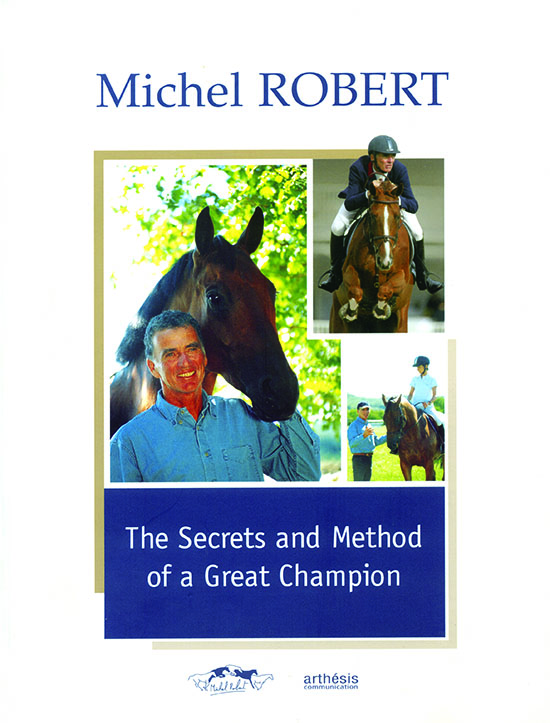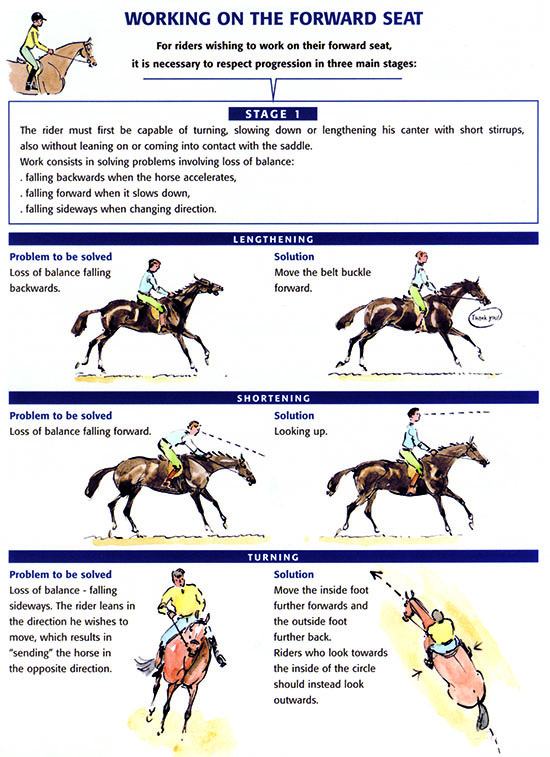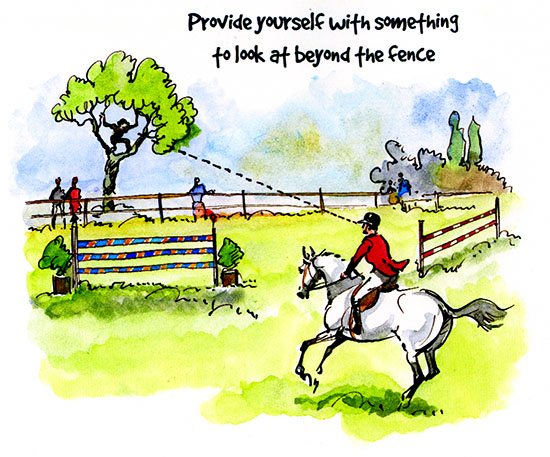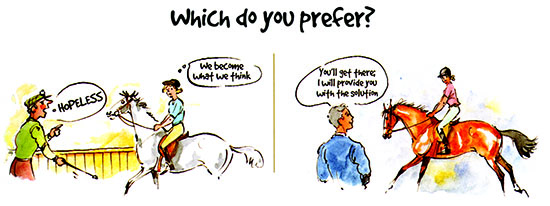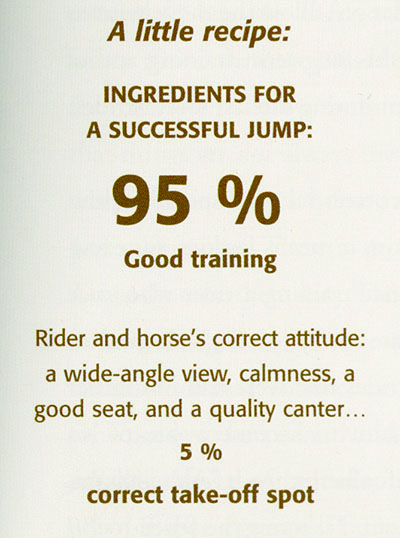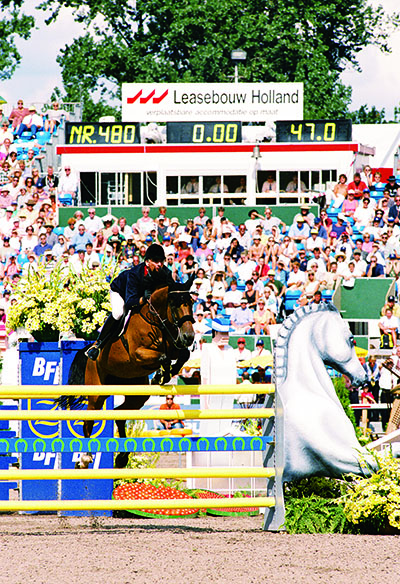New insights into riding and jumping – A review by Chris Hector
Sadly most of the authors of equestrian books are better at the business end of a word processor than they are in the saddle. Rare it is to find a book written by a great and proven international competitor – rarer still that this book should be not only well and interestingly written, but more than that, brilliantly illustrated and presented AND better still that the message is filled with the kind of wisdom and insight you would expect from the great French rider, Michel Robert.
I must confess that some of M. Robert’s more ‘alternative’ tendencies left me cold but any New Age warm and feelies are more than compensated for by the hard won gold nuggets of advice that come from a lifetime’s riding, competing and training. Perhaps he is talking about me, when he writes:
“I am sure that in reading this book, each person will understand what he wishes to understand. You will certainly agree with me until the moment in which you read the words that affect you personally, precisely those words you are most in need of to progress. At that point you will no doubt say to yourself: ‘He overdoes things a little’ or else: ‘I don’t understand what he means’ or perhaps: ‘Yes but for me, it’s different…’ Make an effort, be aware of the moment in which you lose your concentration. It is precisely the words that bother you, which you are most in need of. One must overcome mental resistances. In sending my book to a number of friends so they could proof read it, I noticed that the passages that gave rise to the most criticism or reticence were precisely those discussing subjects embarrassing to them…”
This is a book about the mind and the spirit as much as it is about the technical aspects of training a jumping horse.
“Concentration is a daily exercise, a gymnastic for the mind. For certain people this may seem a simple exercise, for others it is seriously difficult. One of the secrets of concentration is that one can appeal to the fascination of the mind… comparable to love. The more pleasure we get out of whatever we are doing, the easier it is to fix our attention without allowing ourselves to be distracted. The same applies to love – the one we love occupies our thoughts without our having to make an effort.”
Even the most jaded world weary cynic would have to warm to the openness and warmth of this book, especially when it is laced with anecdotes of the world’s best riders in action – as in: “When I asked Willi Melliger to ride over a certain exercise with his horse, he always took about fifteen seconds, at a halt, to plan what he was going to do. It was only when everything was clear in his mind that he started the exercise.”
Or this one: “It is crucial to dominate one’s fear in order to dominate one’s gestures. One can only achieve this control by gaining self-confidence. At La Baule I was recently the last competitor to ride in the jump-off for a Grand Prix. Peter Charles and the others had ridden very fast clear rounds. Before entering the ring, I told our team coach Jean-Maurice Bonneau: ‘I’ll be faster than Peter Charles.’ I had planned my course in detail and with 100% clarity. In my mind, I had already ridden the course; all that remained to be done was to allow my movements to act instinctively: the track, the approaches, the speed… nothing had been left to chance. The clock stopped: mine was the fastest round and clear!”
Throughout the book there are little info boxes, like this one:
Breathing indicating mental tension
I have had many occasions in which I became aware that the rider’s breathing influenced the horse’s behaviour. This was the case during a training session with one of my pupils.
His horse had stopped three times in front of a small fence. Observing the scene, I noticed that it had not breathed since the turn.
So, I asked the rider to repeat the fence. He himself had blocked his breathing riding the turn at about six or seen strides from the jump. While training, this rider had taught his horse to behave exactly like him.
I asked the rider to canter and sing at the same time. Initially, while his breathing was blocked, this proved a difficult task; then both he and his horse progressively started to breathe again… and to jump.
Personally, I have the habit of humming and whistling while I jump a course. Even when I ride in big classes; it’s a good way to make oneself breathe.”
The other wonderful feature of this book is the delightful illustrations – like this one:
Michel Robert is particularly good on how the rider’s perception, even his physical perception, can influence the way he rides:
“I myself regularly practice jumping with my eyes shut or turning my head to one side.
It is impossible to imagine to what extent simply ‘disconnecting’ the eyes can improve one’s seat, help the understanding of a movement and improve harmony with the horse… The most rigid rider can become supple over a very short period of time. Once again, rigidity and hardness are, above all, mental and not physical as most of us tend to believe.”
“Everyone is capable of using a wide-angle view. I have tested this on riders of all ages and all levels. I have come across riders with totally stuck and rigid seats, blocked shoulders and gritted jaws… It would have taken ten years to solve all their problems. In two sessions, we achieved exceptional results simply working on their minds… through their eyes. I never even mentioned their seat, their horses, or their manner of approaching fences, until they were able to control their eyes. As they repeated the exercises, looking in the right direction, their movements became totally relaxed and above all, they managed to establish a trusting relationship with their horses. Absolutely everyone can achieve results like this.”
Yet another delightful illustration makes the point:
According to Michel, you can even have a rail thinking about your pals sitting in the riders’ stand:
“I was in the riders’ stand once at a CSIO watching the competitors. A rider was just about to complete a clear round but at the end of the course… his horse stopped at the last fence. I overheard a number of riders who were watching exclaim: ‘This horse really is a cow! Stopping at the last fence!’ I must admit that these reactions upset me. I was unable to resist the temptation of going to talk to the rider after the class to ask him to talk to me about this refusal. Just like most of those watching he was convinced his horse had made up its own mind to put in a stop. I suggested that he should not simply consider this one explanation, but should try to discover the primary cause of this refusal starting from his own state of mind rather than that of his horse. In analysing correctly his own attitude while approaching the fence, the rider quickly became aware that effectively it had all started in his mind. His horse had nothing to do with it at all. While riding past the riders’ stand, he had suddenly allowed his concentration to wander. He started to think about what the others thought of him, of his riding. From that moment onward, his movements had lost their spontaneity: he wanted to do things really well. The result was that he stuck his spurs into the horse’s sides and it reacted to his sudden and unjustified aggression by simply stopping and refusing to jump.”
All through this, the message is not just be thoughtful and considerate to the horse, but also the human – the pupil.
It really is such a thoughtful innovative book, there is even a dressage test for jumping horses, another neat little check-it-yourself exercise. There are brilliant explanations of preparing the horse to jump and then, perhaps the core of this new masterpiece – how to jump. How to see a stride, how to get a stride, even how to calculate strides in relation to the height of the fences. Once again the emphasis is on building confidence:
“Train over easy exercises, with correct distances and very small fences: a pole on the ground – 3 easy strides – an upright measuring 30 centimetres – a cross – 4 easy strides – a small oxer… With the mind free of all worries, the rider becomes aware of events and can calmly visualise the distance separating him from the next fence. Repeating correct strides allows one to memorise the feeling of an ideal approach. One must create images and sensations that will become reference points in the rider’s mind. As long as the rider is not self-confident, there is no point in raising the fences. This applies to everyone, at all levels!”
And once again, one of those cute little info boxes:
This is only one of 18 beautifully detailed jumping exercises:
OBJECTIVE
For horses with a tendency to jump too ‘big’, this exercise allows one to transform a long jumping trajectory into height.
It is crucial to approach the fences and land perpendicularly to the line. There is no point in putting up the fences if the rider is unable to keep his horse straight and in the centre of the exercise.
This exercise in particular requires a slow and cadenced working canter while approaching. One must not tolerate any lengthening of the stride. If the horse speeds up three strides off the first fence, the rider must circle or halt. This form of training is effectively totally incompatible with a rider who is out of control or a horse that rushes its fences.
Equally, this line cannot be ridden if the rider does not maintain wide-angled vision.
The chapter on competing has to be read over and over by any serious competitor, as it goes over walking the course, warming up the horse, riding the track and analysing the result. Just read it.
This wonderful new book finishes as it started, in inspirational mode:
“I am aware that for many of you, some of my methods will seem rather dissimilar to those of other people. What I hope for is to provide you with solutions that will simplify your life. Bear in mind however, that one gets nothing for nothing. It is not a question of money, but effort and hard work. To progress one must repeat things over and over again. Accept that you will experience great moments of joy, new sensations that must be memorised, and tough times during which you must absolutely look to the future. There is good everywhere, smile, sing and life will smile at you, other people and horses will love you. The good times are many; all you have to do is look at life thought positive and wondrous eyes.
The Rider’s Mind….
The rider’s state of mind is crucial to ensure that the horse accepts a stranger on his back. Personally, I devote my energy to c0ntrolling my mind and to trying to stay calm, contantly analysing my seat and the horse’s reactions. At The Hague, the most sensitive and difficult horse to ride was certainly Ratina Z. This mare’s personality left no one indifferent: neither the riders nor the spectators… I only had a few minutes to get to know her, which was really too little. I instantly put myself in a state of mind of admiration and respect for this mare. I approached her calmly, and my only intention was to love her and understand her. I placed my open hand on her shoulder and we exchanged information about our personalities. A sort of fluid moved between us. Magical moments such as these are engrave on my memory. Once in the saddle, I ‘glued’ myself to her, to better feel and encourage her. We both made the best possible use of each other’s qualities and… it was a clear round!
A clear round for Michel Robert and Ratina in the four horse, four rider ride off for World Champion at The Hague in 1994.


